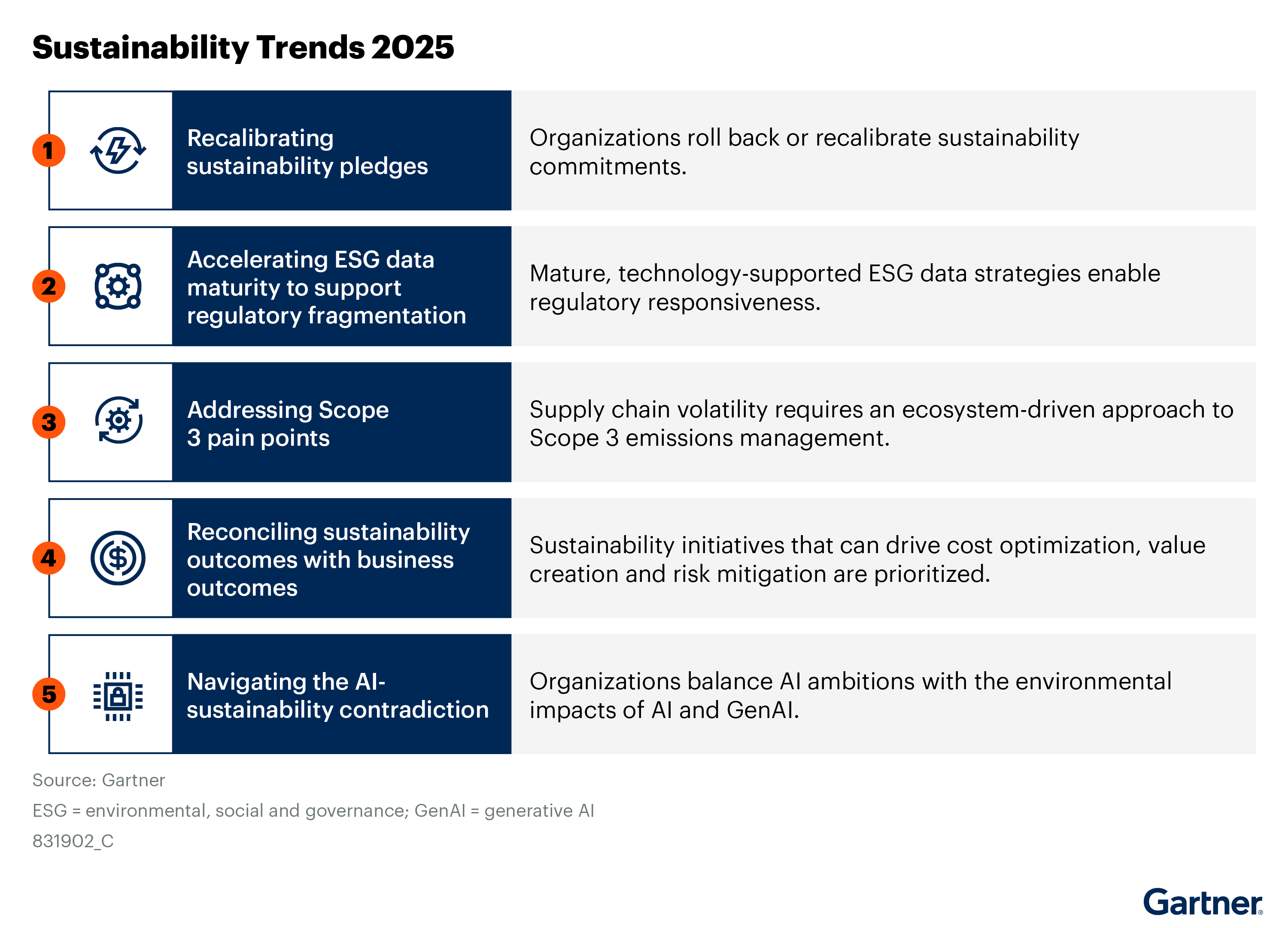Five trends redefining sustainability strategies in 2025
Five trends redefining sustainability strategies in 2025
While some countries tighten sustainability requirements and others relax them, Australian businesses are staying the course, refocusing efforts, reprioritising initiatives, and embedding sustainability more deeply into core strategy. The challenge now lies in navigating complexity and translating ambition into credible, achievable action.
According to Gartner®: “the 2025 Gartner CEO and Senior Business Executive Survey found that environmental sustainability remains a top 10 CEO priority for 2025.” Yet despite widespread materiality assessments, many leaders are still grappling with how to turn these insights into cohesive strategies. In response, Gartner has identified five key trends that are reshaping sustainability strategy. See Figure 1 below.

Gartner, 5 Trends Shaping Sustainability Strategies in 2025, Figure 1
Trend 1: “Recalibrating sustainability pledges”
In recent years, both global and Australian businesses have made ambitious sustainability commitments, driven by stakeholder expectations and regulatory changes. But as cost pressures mount and political sentiment shifts, many are reassessing how to deliver on these goals.
For Australian businesses, scaling back is not a viable option. With mandatory climate-related financial disclosures, organisations must move beyond aspirational targets to credible, actionable plans. We’re at a critical juncture to refocus efforts on initiatives that deliver both environmental and commercial value, such as energy efficiency, operational resilience and supply chain optimisation. Australian leaders can’t afford to step away from sustainability. They must lean in and embed it more deeply within business strategy, aligning ambition with capability through honest, pragmatic action.
Trend 2: “Accelerating ESG data maturity to support regulatory fragmentation”
Manual ESG reporting just doesn’t cut it anymore. As Gartner highlights, businesses must invest in scalable, flexible and AI-enabled data capabilities to improve accuracy, speed and compliance with evolving sustainability requirements.
With global regulations still fragmented, it’s easy to get caught up in the complexity. But the real opportunity lies in what’s within reach: building strong ESG data foundations that support transparency, decision-making and long-term value. That means investing in systems that can adapt to change, and embedding robust data governance across IT, finance and operations.
For Australian businesses, this is a chance to take control of the ESG narrative. By developing a unified, enterprise-wide view of sustainability data, leaders can move from reactive reporting to proactive strategy, turning compliance into a catalyst for performance and resilience.
Trend 3: “Addressing scope 3 pain points”
According to the Carbon Disclosure Project, Scope 3 emissions can account for up to 70% of a business’s carbon footprint. With geopolitical risks, trade restrictions, and tightening sustainability regulations adding pressure, many organisations are rethinking supplier relationships, manufacturing locations, and sourcing strategies. According to Gartner: “the scarcity of low-carbon inputs and components is already driving competition, with early movers securing preferential pricing, reputational gains and resilience.”
For Australian businesses, this means taking decisive action to build low-carbon, low-risk supply chains. Partnering with suppliers who have stronger emissions profiles, leveraging AI and scenario modelling to identify vulnerabilities, and embedding sustainability into procurement decisions are essential.
Collaboration is key. Sharing data, setting clear emissions targets, and tracking progress with suppliers and industry partners will help Australian organisations remain competitive in a resource-constrained market.
Trend 4: “Reconciling sustainability outcomes with business outcomes”
Gartner states that: “in a resource-constrained environment, many organisations are renewing their focus on core business outcomes tied to sustainability. These include cost optimisation, such as energy efficiency; asset optimisation to reduce both costs and waste simultaneously; Climate scenario modelling to minimise risk exposure from climate-related events.”
In today’s volatile economic and geopolitical environment, many organisations are prioritising short-term needs like supply chain security and cost control. The opportunity lies in embedding sustainability into core business processes, including mergers and acquisitions, research and development or finance, so that immediate decisions also support long-term goals.
For Australian businesses, this means integrating sustainability criteria into everyday decision-making. From setting acceptable climate risk thresholds for suppliers to aligning capital investments with low-carbon growth, the focus should be on unlocking efficiencies and reducing exposure. By taking a whole-of-business view, leaders can enhance profitability, reduce risk and build lasting sustainability success.
Trend 5: “Navigating the AI sustainability contradiction”
Gartner® (2025) predicts that “by 2028, AI is expected to be widely used by large enterprises to optimise sustainability initiatives through the optimisation of emission reduction pathways and enhancement of biodiversity accounting.”. While AI, especially generative AI (GenAI), can dramatically improve data processing and automation, it also comes with a significant environmental footprint due to its energy and water demands.
Australian businesses must now weigh AI's sustainability benefits against its resource intensity. Conducting energy risk assessments of data centres and investing in renewable energy sources, like on-site solar, are practical steps to reduce the environmental cost of AI infrastructure.
Beyond resource consumption, ethical considerations around data privacy, accuracy and human oversight remain critical. Gartner recommends establishing human-centred governance frameworks that engage employees and ensure responsible AI deployment.
The benefits of AI cannot be denied, but to ensure it contributes positively to long-term sustainability goals, businesses must balance innovation with environmental and ethical responsibility.
Staying focused amid change
For Australian businesses, the challenge isn’t a lack of commitment, but a narrowing window to comply with emerging regulations and a growing need to understand what’s required.
As mandatory climate disclosures come into effect, organisations are reprioritising, refocusing, and staying the course. The emphasis is now on clarity, capability, and credible action, ensuring sustainability strategies are not only ambitious but achievable.
Navigating this requires more than good intentions. It demands practical planning, informed decision-making, and the right partnerships. At BDO, we help businesses clarify their sustainability goals and build strategies that deliver measurable impact. Contact us today.
Gartner, 5 Trends Shaping Sustainability Strategies in 2025, 15 May 2025
GARTNER is a registered trademark and service mark of Gartner, Inc. and/or its affiliates in the U.S. and internationally and is used herein with permission. All rights reserved.
